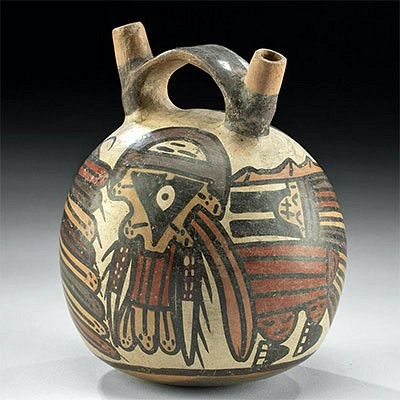1930s Japanese Wire & Silk Fabric Dolls (pr)
Lot 52a
About Seller
Artemis Gallery
686 S Taylor Ave, Ste 106
Louisville, CO 80027
United States
Selling antiquities, ancient and ethnographic art online since 1993, Artemis Gallery specializes in Classical Antiquities (Egyptian, Greek, Roman, Near Eastern), Asian, Pre-Columbian, African / Tribal / Oceanographic art. Our extensive inventory includes pottery, stone, metal, wood, glass and textil...Read more
Categories
Estimate:
$1,300 - $1,950
Absentee vs Live bid
Two ways to bid:
- Leave a max absentee bid and the platform will bid on your behalf up to your maximum bid during the live auction.
- Bid live during the auction and your bids will be submitted real-time to the auctioneer.
Bid Increments
| Price | Bid Increment |
|---|---|
| $0 | $25 |
| $300 | $50 |
| $1,000 | $100 |
| $2,000 | $250 |
| $5,000 | $500 |
| $10,000 | $1,000 |
| $20,000 | $2,500 |
| $50,000 | $5,000 |
| $100,000 | $10,000 |
| $200,000 | $20,000 |
About Auction
By Artemis Gallery
Feb 10, 2022
Set Reminder
2022-02-10 10:00:00
2022-02-10 10:00:00
America/New_York
Bidsquare
Bidsquare : Ancient & Ethnographic Art Through The Ages
https://www.bidsquare.com/auctions/artemis-gallery/ancient-ethnographic-art-through-the-ages-8873
Join us for Part Two of a spotlight on two fabulous collections, one from Lumberton, Texas, and the other from Whisnant Gallery in New Orleans. Artemis Gallery info@artemisgallery.com
Join us for Part Two of a spotlight on two fabulous collections, one from Lumberton, Texas, and the other from Whisnant Gallery in New Orleans. Artemis Gallery info@artemisgallery.com
- Lot Description
North Pacific, Hawaii, ca. 1930s CE. Made in Hawaii by a Japanese artist. A splendid and sizeable pair of Japanese dolls known as ningyo representing a geisha and an oiran - a top-rated courtesan of the bordello districts which were abolished in the 1950s - each comprised of a stuffed wire skeleton and a plastic face covered with crepe silk fabric, as she stands on a wooden base. Both women wear their hair in elaborate updos embellished with floral or shell decorations as they tilt their faces to their right, each displaying an elegant, painted visage of slender eyes beneath a straight brow, a naturalistic nose, and a petite smile. Both elaborately dressed, the oiran is draped in an elaborate floral kimono in hues of orange, pink, blue, yellow, green, beige, and white, as well as a broad brown obi or belt, a red underskirt, platform sandals known as zori, and a brown pillow strapped to her back. Size (of largest): 7" W x 25.5" H (17.8 cm x 64.8 cm); 26.7" H (67.8 cm) on included custom stand.
Alternatively, the geisha wears a brown and white kimono with a thick gold belt and a floral underskirt, while holding a samisen - a traditional Japanese 3-stringed plucked instrument - in her right hand.
According to Dr. Judy Shoaf, director emerita of the University of Florida College of Liberal Arts and Sciences, "Though the silk-faced ningyo are often generically referred to as "geisha dolls," only a few specifically represent the historical type of the geisha. The training (and regulating) of ladies as professionals in the art of pleasing men is an old tradition in Japan, dating at least from the early 17th century when the Yoshiwara pleasure quarter was established in Edo. The Yoshiwara women were vital to the imaginations both of the woodblock artists and of the kabuki drama. A particularly beautiful and accomplished woman of pleasure might be called a keisei, or 'castle-toppler.' The celebrities among these women of pleasure were called oiran; an oiran could pick her lovers among the wealthiest citizens (or love a poor man as well if she chose, especially in a play!), and she might walk out elaborately dressed (brocade obi tied in front, high platform geta shoes, and the most elaborate hairstyle possible), attended by apprentices and little girls. A different class was the geisha, originally an entertainer who played and sang for the oiran and her customers...A geisha is usually presented as a doll in a rich dark kimono with a simple obi, ready to play her samisen."
Provenance: private Hawaii, USA collection, acquired September 2020; ex-Kimura collection, Hawaii, USA, Mrs. Kimura made the dolls in the 1930s
All items legal to buy/sell under U.S. Statute covering cultural patrimony Code 2600, CHAPTER 14, and are guaranteed to be as described or your money back.
A Certificate of Authenticity will accompany all winning bids.
PLEASE NOTE: Due to recent increases of shipments being seized by Australian & German customs (even for items with pre-UNESCO provenance), we will no longer ship most antiquities and ancient Chinese art to Australia & Germany. For categories of items that are acceptable to ship to Australia or Germany, please contact us directly or work with your local customs brokerage firm.
Display stands not described as included/custom in the item description are for photography purposes only and will not be included with the item upon shipping.
#168183Repair to 1 tuning peg of gottan. Expected light surface wear and fading to fabric. Otherwise, both are intact and excellent.Condition
- Shipping Info
-
All shipping is handled in-house for your convenience. Your invoice from Artemis Gallery will include shipping calculation instructions. If in doubt, please inquire BEFORE bidding for estimated shipping costs for individual items.
-
- Buyer's Premium



 EUR
EUR CAD
CAD AUD
AUD GBP
GBP MXN
MXN HKD
HKD CNY
CNY MYR
MYR SEK
SEK SGD
SGD CHF
CHF THB
THB














